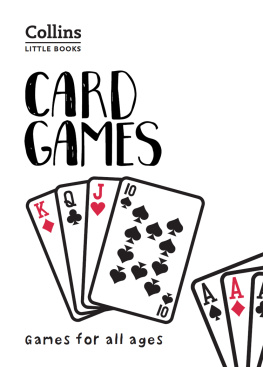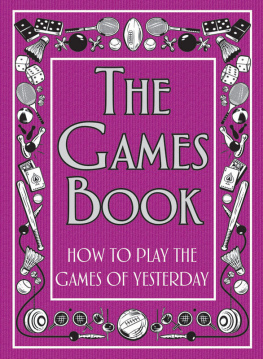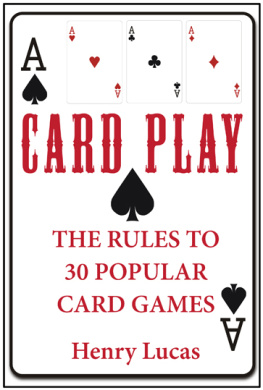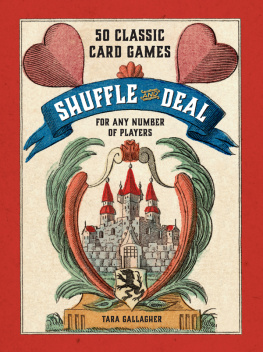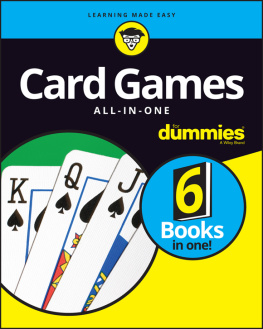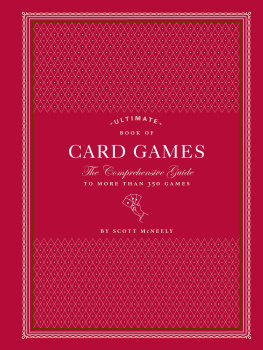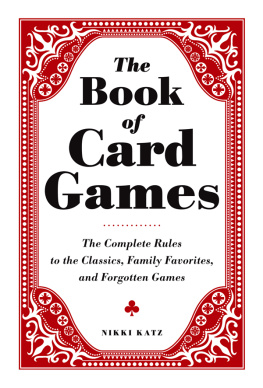Ian Brookes - Card Games: Games for all ages (Collins Little Books)
Here you can read online Ian Brookes - Card Games: Games for all ages (Collins Little Books) full text of the book (entire story) in english for free. Download pdf and epub, get meaning, cover and reviews about this ebook. year: 2018, publisher: HarperCollins UK, genre: Children. Description of the work, (preface) as well as reviews are available. Best literature library LitArk.com created for fans of good reading and offers a wide selection of genres:
Romance novel
Science fiction
Adventure
Detective
Science
History
Home and family
Prose
Art
Politics
Computer
Non-fiction
Religion
Business
Children
Humor
Choose a favorite category and find really read worthwhile books. Enjoy immersion in the world of imagination, feel the emotions of the characters or learn something new for yourself, make an fascinating discovery.
- Book:Card Games: Games for all ages (Collins Little Books)
- Author:
- Publisher:HarperCollins UK
- Genre:
- Year:2018
- Rating:3 / 5
- Favourites:Add to favourites
- Your mark:
- 60
- 1
- 2
- 3
- 4
- 5
Card Games: Games for all ages (Collins Little Books): summary, description and annotation
We offer to read an annotation, description, summary or preface (depends on what the author of the book "Card Games: Games for all ages (Collins Little Books)" wrote himself). If you haven't found the necessary information about the book — write in the comments, we will try to find it.
Ian Brookes: author's other books
Who wrote Card Games: Games for all ages (Collins Little Books)? Find out the surname, the name of the author of the book and a list of all author's works by series.
Card Games: Games for all ages (Collins Little Books) — read online for free the complete book (whole text) full work
Below is the text of the book, divided by pages. System saving the place of the last page read, allows you to conveniently read the book "Card Games: Games for all ages (Collins Little Books)" online for free, without having to search again every time where you left off. Put a bookmark, and you can go to the page where you finished reading at any time.
Font size:
Interval:
Bookmark:

Australia
HarperCollins Publishers (Australia) Pty. Ltd.
Level 13, 201 Elizabeth Street
Sydney, NSW 2000, Australia
http://www.harpercollins.com.au
Canada
HarperCollins Canada
Bay Adelaide Centre, East Tower
22 Adelaide Street West, 41st Floor
Toronto, ON, M5H 4E3, Canada
http://www.harpercollins.ca
India
HarperCollins India
A 75, Sector 57
Noida, Uttar Pradesh 201 301, India
http://www.harpercollins.co.in
New Zealand
HarperCollins Publishers (New Zealand) Limited
P.O. Box 1
Auckland, New Zealand
http://www.harpercollins.co.nz
United Kingdom
HarperCollins Publishers Ltd.
1 London Bridge Street
London SE1 9GF
http://www.harpercollins.co.uk
United States
HarperCollins Publishers Inc.
195 Broadway
New York, NY 10007
http://www.harpercollins.com
The exact time and place when card games were invented cannot be known for certain. However, it is fairly clear that playing cards just like paper, clocks and fireworks started life in China, and that the first cards were produced before AD 1000. These cards probably featured symbols that represented coins, and would have looked more like modern-day dominoes than the cards in modern deck.
From China, the use of playing cards spread through Asia, and it was the Mamelukes, a group of soldiers who had established a powerful empire in Egypt, who introduced playing cards to Europe around 1370. The earliest European packs had 52 cards divided into four suits, just like a standard modern pack, although the designs on the cards were markedly different from what we know today.
THE DEVELOPMENT OF THE FOUR SUITS
The playing cards that came from Egypt contained designs influenced by Islamic culture, with cups, swords, coins and polo sticks. As cards became popular across Europe, different countries would produce variations on these designs that made more sense to the local people. Thus the polo stick which was not known in Europe at the time was transformed into a baton in southern Europe, while in Germany the symbols of acorns, leaves, hearts and bells eventually became standard.
At this point playing cards were hand-painted, and so they were expensive to produce and could only be afforded by rich people. However, around 1480, French manufacturers realised that by making the patterns on the cards simpler, the cards would be cheaper to produce. They came up with four simple shapes that could be drawn using a stencil: the trefoil (the modern club), the diamond, the heart, and the pike-head (the modern spade).
The new French designs made playing cards available to many more people, and the French pack has gradually became accepted as the international standard. However, there are still regional variations that can be dated back to the earlier suit designs, such as bells being used as a suit in Germany and Switzerland or cups being a suit in Italy and Spain.
OTHER CHANGES IN THE PACK
The idea of having thirteen cards of a different value in each suit was already present when cards arrived in Europe. The one significant difference was that the early sets had three male court cards: a king, a knight and a servant. The queen was later added instead of the servant and was given a value between the knight and the king, and the knight was also renamed as the knave or jack.
The pack has changed in other ways over the years too. Until around 1800 the backs of the cards were plain white. This meant that the cards could be discoloured and even deliberately marked, and by remembering these marks a dishonest player might be able to know the value of a card that was face down or in an opponents hand. To stop this from happening, manufacturers took to printing coloured designs on the backs of the cards.
Another relatively late innovation to make playing card games fairer was the idea of adding the number and suit of each card in the corner as well as in the middle of the card. Before this was done, players had to hold a card away from the rest of their hand to see what it was, and this might expose the card to an opponents view. But from the 1860s the value of each card was printed in the corner, and so players could hold their cards together in a tight fan and get a quick view of all the cards in a hand without giving much away.
Around the same time, card manufacturers began to include two jokers in the pack. These cards could be used to stand in for a lost or damaged card so that a pack did not become useless if one card went missing. However, they were also accommodated into various games so that a player with a joker could use it to represent any card in the deck. The fact that the jokers are a late addition to the deck accounts for the fact that not many of the established card games use them.
TYPES OF CARD GAME
The earliest card games seem to have involved a series of rounds in which each player played one card and the card with the highest value won that round or trick. These games could be made more interesting by having a trump suit, so that a card of that suit would automatically beat any card of the other suits.
Early trick-taking games included triumph and ombre (which introduced the idea of having an auction to decide the trump suit before the hand was played rather than cutting a card to decide the trumps). The game of triumph later evolved into whist, which was widely played in coffee houses and drawing rooms in the eighteenth and nineteenth centuries. In the twentieth century contract bridge overtook whist and became established as the most popular trick-taking game among expert players.
While trick-taking games have remained popular, card games that work in other ways have also emerged. There is, for example, a whole family of games that involve arranging the cards in a hand to form matching sets and sequences. These games probably derive from conquain, which was developed in Mexico in the nineteenth century. Probably the best-known game of this kind is rummy, while canasta is a more complex variation on the same theme that involves two packs of cards.
Another distinctive type of game is patience, where a player has no opponents but must try to sort the pack into a pattern while being restricted to certain moves. This sort of card game is first recorded in northern Europe in the 1780s and probably developed from the practice of dealing out cards into patterns as a way of predicting the future.
The fact that so many different types of game can be played using the same pack shows just what a remarkably flexible invention playing cards are. The games included in this book have been chosen to offer something for everyone and for every occasion. They include games that are simple to learn and that everyone can play (such as snap and war) alongside complicated games that require players to use subtlety and strategy (such as canasta and cribbage). They include games for one player (clock, solitaire), games for two players matched head-to-head (bezique, gin rummy), and games that can be enjoyed by larger groups (hearts, Newmarket). Some of the games require great skill while others are entirely dependent on chance. While many of the games in the book are played quite widely, there are also a few games that are not so well-known, so that even experienced card players will find something new here.
 |
A game for two or three players similar to whist.
CARDS
The standard deck of 52 cards is used with ace ranking high. A suit is assigned trumps which outranks all other suits. A set of two or three cards, one from each player in turn, is called a trick.
Next pageFont size:
Interval:
Bookmark:
Similar books «Card Games: Games for all ages (Collins Little Books)»
Look at similar books to Card Games: Games for all ages (Collins Little Books). We have selected literature similar in name and meaning in the hope of providing readers with more options to find new, interesting, not yet read works.
Discussion, reviews of the book Card Games: Games for all ages (Collins Little Books) and just readers' own opinions. Leave your comments, write what you think about the work, its meaning or the main characters. Specify what exactly you liked and what you didn't like, and why you think so.

